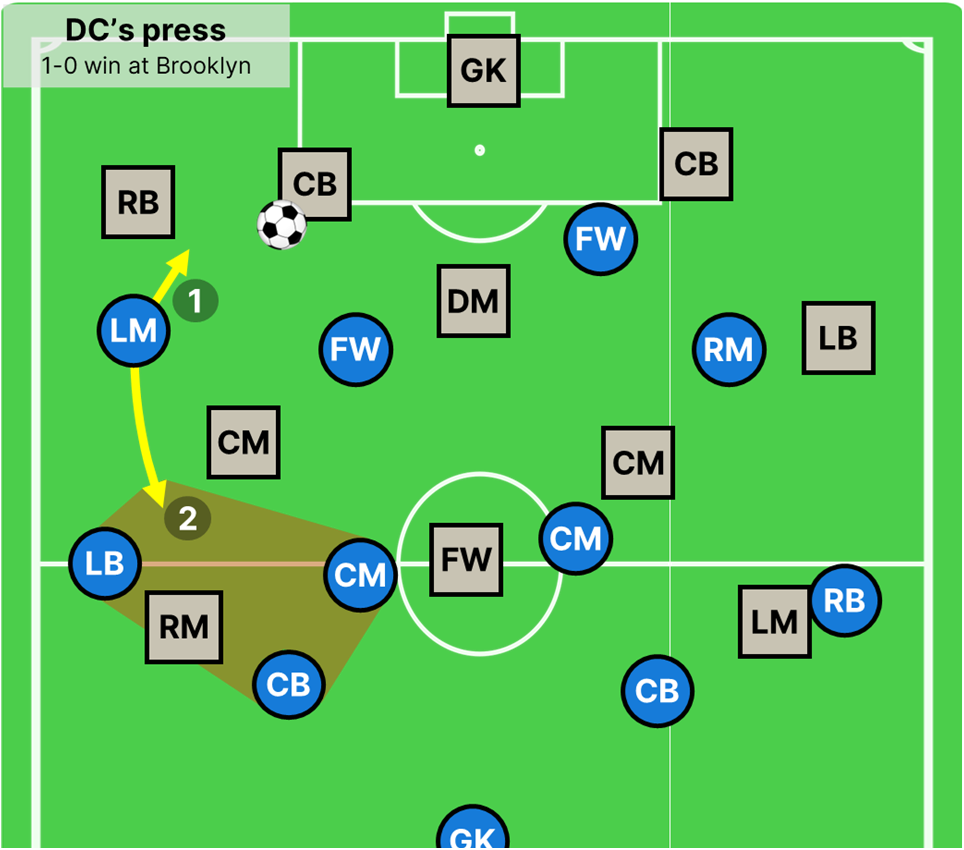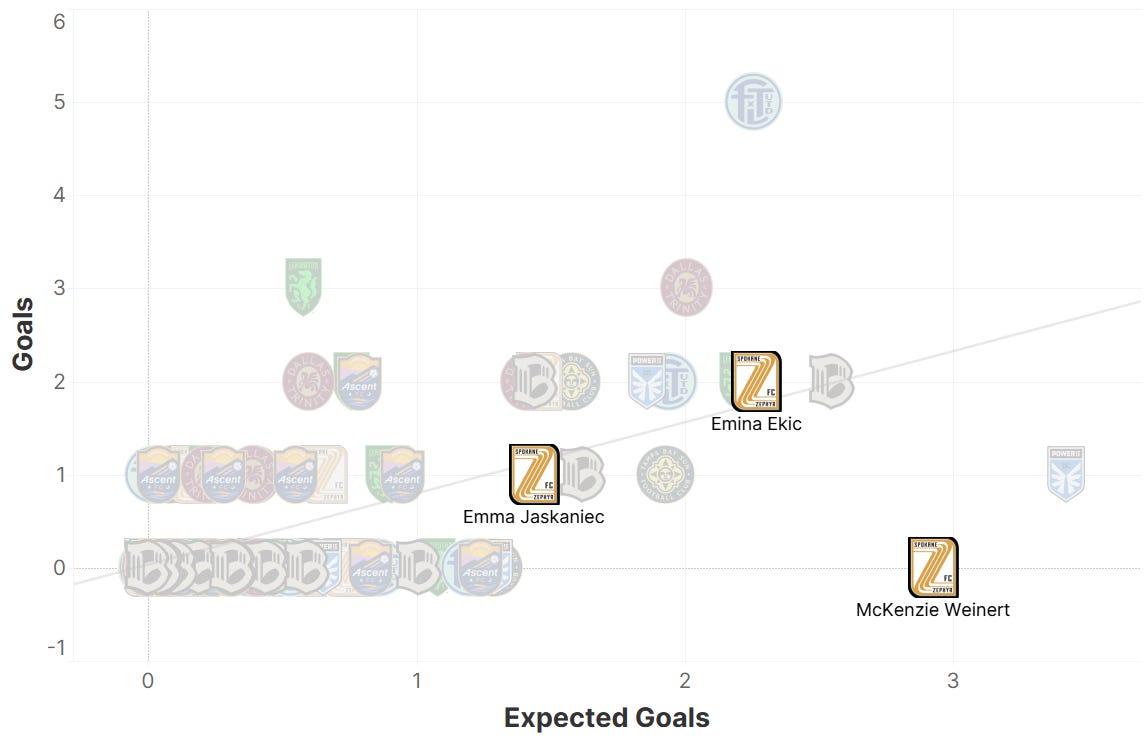Takeaways from USL Super League Week 9
How DC Power and Lexington SC earned their first-ever Super League wins
It’s official: every club in the Super League is off the schneid. Because of hurricane-related delays (best wishes to everyone in the Tampa Bay region!) it was a slim matchweek, but one filled with interesting tweaks and exciting games nonetheless. In lieu of a full power ranking, let’s dig into the big wins for DC and Lexington.
Brooklyn FC (0) - DC Power (1)
It’s cliche to note that defense wins championships, but if you’re DC Power, competent defense is what it took to finally win a single game. That DC did so away to Brooklyn was particularly impressive. This club hasn’t solved all their problems yet - they lost the xG battle 1.8 to 0.6 at Rocco Commisso Stadium - but they’re doing enough to stay in the race.
Frederic Brillant didn’t blow up his system in the process. Power still pressed in a high 4-4-2 and possessed in a 3-5-2 with Susanna Friedrichs pushing high from right back. What Brillant did change was the positioning of his midfield. The two DC center mids deepened out, and his wingers were given more holistic responsibilities without the ball.
DC’s high press tried to use partnerships between the ball-side winger and forward to compress and deny the channels. They weren’t terribly concerned about Sam Kroeger, Brooklyn’s lone holding mid, as a creative option; she often took up positions at the level of her center backs anyway.
If Brooklyn did find a way through, the pivot pair of Katelyn Duong and Jeannette Yango was ready to engage. Each half of the duo went the full 90 minutes, combing for 10 recoveries (seven of which came in the defensive half) and nine further defensive actions. Neither lost a tackle attempt, and they conceded just one foul in their defensive zone. It was a masterclass in efficiency.
As I’ve discussed quite a bit, Brooklyn’s best attacking moves come when they can hit a No. 8 or inside-tucking winger between the lines. Once that happens, the receiver can either dribble in for a shot, look to the weak side for a runner, or cut a pass back toward an overlapping full back on their near side. By clogging the zone with the Duong-Yango pivot, DC prevented those patterns from bearing much fruit.
Brooklyn still found looks. Mackenzie Pluck started to drop deeper in the central midfield to try and force Power out of shape. Leah Scarpelli was bright with a head of steam, whether advancing off a defensive takeaway or turning around a presser out of the left back spot.
Still, Jessica Silva’s side was often forced to look long, and that was a problem. Brooklyn punted it on a relatively high 15% of their pass attempts but only won 36% of aerial duels. They made just one recovery in the final third, evidence of a meek ability to contest knockdowns.
Much of the overarching inefficiency owed to DC’s stellar shape. You often hear a low-block 4-4-2 described as having “banks of four” in deep areas, and Power exemplified that phrase.
Above, DC sits deep as Brooklyn breaks against their left side. The ball carrier is at the far sideline, so Power’s Amber Diorio (the left back) steps to her. The response from there is crucial: Yango and left winger Anna Bagley both drop low to replace Diorio and assure that Brooklyn can’t easily work around the closing defender. Bagley and Yango make sure that neither an over- nor underlap can bear immediate fruit.
Because Mackenzie George is a terrific soccer player, she squeezes past the Bagley-Diorio double and finds a cross from the endline. Still, this is where DC’s rotation truly shines. The contributions from low-dropping midfielders assure that the core of the Power back four can stay home. Friedrichs and center backs Claire Constant and Madison Wolfbaeur all occupy the penalty box, and they can clog the zone when George’s cutback yields a shot.
Now, these aren’t the situations you want to be facing all the time as a defense. Concede enough shots, and you’re destined to slip up eventually. This level of discipline, however, is a bright sight for a DC side that hasn’t always nailed down the basics. On Friday, they defended well and found enough 1-2-3 zone exit passing plays (think Constant to Friedrichs to Jorian Baucom in quick succession) to keep Brooklyn honest.
The home team was ultimately unlucky not to score, and subbing Dana Scheriff on at striker with Samantha Rosette on the right wing proved to be a nice in-game adjustment. Fitting Rosette into the team was especially promising; she’s clearly a stellar passer with great instincts, but she may be more useful upfield given Scarpelli and Sasha Pickard’s performances at full back.
So, yeah, Brooklyn was sharper. Yes, DC only got two shot attempts in the second half. Even so, Power kept it clean and set themselves up for their unlikely winner. That’s why the game isn’t played on an xG basis.
Spokane (2) - Lexington (3)
Almost no other club in the Super League has matched Lexington’s ability to look dominant in short bursts. This team typically starts games well, and their clutch finishes have been the story of October. Actually turning solid 10- or 15-minute sequences into goals has been Lexington’s problem, but they finally did so in Spokane on Sunday.
Zephyr came into the match with a new shape, adopting a 4-4-2ish look with a diamond midfield. Rather than use McKenzie Weinert and Emina Ekic as wingers, the former paired with Emma Jaskaniec as a No. 9 whilst Ekic was deployed at the top of the diamond.
Lexington, meanwhile, defended in a 4-2-3-1. The press sometimes looked like a 4-1-4-1, usually driven by Shea Moyer stepping from the pivot as Claire Winter remained deep. The usual aggression remained a constant. Michael Dickey loves for his team to close down hard, and his full backs pushed high into the half spaces to deny passes; the shape almost became a 2-4-4 when Spokane tried to enter the channels.
The give-and-take between systems favored Spokane more often than not. Whether it was Marley Canales (two chances created; three cross attempts in open play) finding a gap on the right or Jaskaniec making a wide dummy run, Lexington was wont to overreact and cede space in behind. That Spokane failed to fully take advantage of their ensuing chances is why they lost the match in spite of a 2.8 to 2.1 xG edge.
Don’t let those numbers take anything away from Lexington, who put up their most fluid performance of the season with the ball. Theirs was an unabashedly outside-in attack, but that’s what was needed against the Zephyr diamond.
Time and again, Dickey’s side would push a full back up the sideline and replace them with a wide-drifting center mid. Above, Lexington starts a build-out play with Nayeong Shin (the left back) advancing and being replaced by Shea Moyer (a holding mid). Instantly, it’s a two-on-one against the wide Spokane mid that drifts over in coverage.
Crucially, Lexington repeats the trick upfield to keep the play going. As Shin advances, winger MaryKate McGuire and forward Madi Parsons execute a similar high-low overload against a full back. With that Spokane defender pinned, there’s room for Parsons to make a run in behind.
Lexington knew how to climb the ladder with the ball, but real goalscoring opportunities only arose if the wide overloads were matched with supporting runs from the weak side. Above, that means midfielder Hannah Richardson shows toward the center for a cutback. It’s no coincidence that Shea Moyer’s 18th minute go-ahead effort came off a cutback after Parsons had been double-teamed in the wide area.
The game entered the break in a tie, but Lexington came out firing yet again in the new half. Within the first five minutes of the second period, they had racked up seven shots and taken the lead anew. They did so thanks to a heightened 4-1-4-1 press, with the goal coming off a forced turnover and a smart cut inside from McGuire to score on the rebound.
Lexington cooled down thereafter, and their choice to invert full backs Courtney Jones and Nayeong Shin was a head-scratcher. Neither was a standout in the first half, but moving Shin rightward and Jones leftward out of the break played into Spokane’s hands and felt extraneous.
Zephyr, meanwhile, returned to a typical 4-3-3 with Ekic on the left and Weinert on the right. The change gave the wingers more freedom to take opponents on, which played splendidly against Lexington’s “ain’t broke, tried to fix it” back line. Interventions from Jaskaniec and center back Haley Thomas generated quick-to-develop chances for each of Ekic and Weinert, culminating in a gorgeous switch from Thomas to Ekic to tie things up in the 58th minute.
Zephyr should’ve gone on to win from there, but poor finishing prevented that from happening. It’s a trend by now. Jaskaniec, Ekic, and Weinert represent three of the USL’s top 15 contributors on an expected basis, accumulating 6.6 xG. In sum, they’ve scored just three goals. Weinert - who’s been unbelievably good at beating defenders and finding space - is the chief culprit; no USL player has more xG without a single conversion.
Spokane had the better chances down the stretch (see a Jenny Vetter look similar to Ekic’s breakaway around the 80th minute) but also ran into a steelier defensive structure around zone 14 on Lexington’s part. That added solidity, largely due to second-half sub Kimberly Mendez, gave the guests what they needed to stay in the match and win on a late set piece.
Just like in the draw against Carolina, the winning corner wasn’t exactly a feat of design. Five Lexington targets crowded at the near-center of the box, and a backtracking Sydney Shepherd was able to head home beautifully against her momentum. Lucky? Maybe, but Lexington did more to make their luck than we’ve seen at any point in 2024.



